Boletus L.
Recent molecular studies have shown that Boletus in its current circumscription is likely an artificial grouping and it is possible that it will be split at some point into smaller genera. Note that Boletus impolitus and Boletus depilatus for practical reasons are retained here, although there is strong evidence that they are closely related to Xerocomus subtomentosus and its allies.
Fruitbody large to medium sized, boletoid, without veil and ring. Stipe solid, with surface usually covered with granules or network. Flesh variously coloured, changing or not when exposed to air. Tubes easily separable from each other, not tearing apart. Pores usually small and rounded.
Boletus satanas Lenz
Description
Cap up to 20 cm, at first hemispherical, then convex to flat-convex, almost white, silvery grey, grey to greyish ochraceous or ochraceous, sometimes developing olivaceous tint with, dry, smooth or sometimes finely cracked, not blueing when bruised. Stipe clavate, usually strongly bulbously swollen at the base; cream, lemon yellow to bright yellow in the upper part, downwards gradually becoming carmine or pinkish red, at least in the upper part with well developed fine, concolorous with the background or red network, blueing when bruised. Tubes at first lemon yellow, then yellow with somewhat olivaceous tint, blueing when damaged. Pores bright red to orange red, gradually becoming paler towards the cap margin, blueing when bruised. Flesh pale lemon yellow in young fruitbodies, later whitish or white in the cap and the stipe, under the cap cuticle often with pink line, blueing when exposed to air. Smell not distinctive, but unpleasant in old fuitbodies. Taste slightly acid. Spores 9.5–16 × 4.5–7.5 μm, ratio 1.8–2.7. Pileipellis (the cap cuticle) trichodermium of interwoven septate hyphae of cylindrical, finely incrusted cells. Chemical reactions: hyphae of the flesh in the stipe base inamyloid with Melzer’s solution.
Habitat. Warm broadleaf forests on calcareous soils, mycorrhizal with oaks (Quercus), beech (Fagus), sweet chestnut (Castanea), hornbeam (Carpinus) or lime (Tilia).
Distribution. In Europe widespread but mostly seldom; much more common in south, in northern areas very rare, absent in the far north.
Similarity. Similar and sometimes probably confused with Boletus rhodoxanthus, Boletus legaliae and B. rubrosanguineus. The two latter however develop pinkish to vinaceous tints on the cap that are usually not seen in B. satanas. In addition B. rubrosanguineus grows mostly in coniferous forests in mountain areas, where B. satanas is not seen. Boletus rhodoxanthus is distinguished on account of the pinkish tinted pileus and the flesh that is yellow and blues in the cap. B. satanas has mostly whitish flesh, blueing both in the cap and the stipe. Compare also with Boletus pulchrotinctus.
Photographs

Well developed fruitbodies of Boletus satanas. Note the bulbously swollen stipe very typical for this species. (photo B. Assyov)
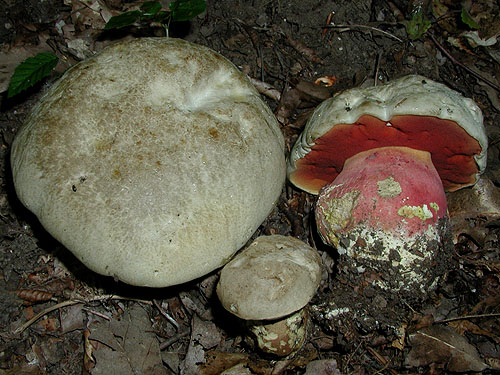
Fruitbodies of Boletus satanas. (photo B. Assyov)
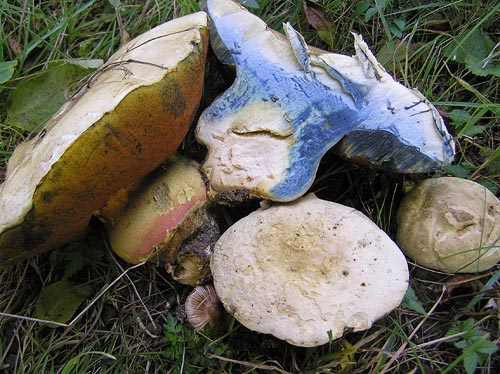
Typical fruitbodies of Boletus satanas. Note the whitish, strongly blueing flesh. (photo H.G. Toresson)
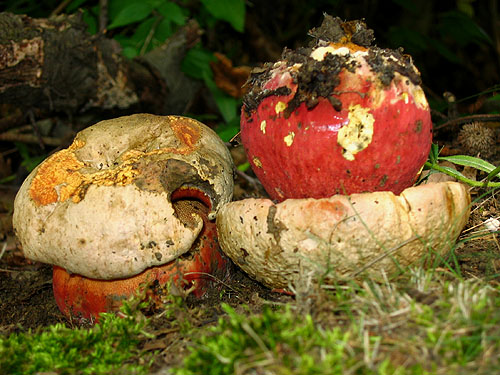
Young fruitbodies of Boletus satanas. (photo B. Assyov)
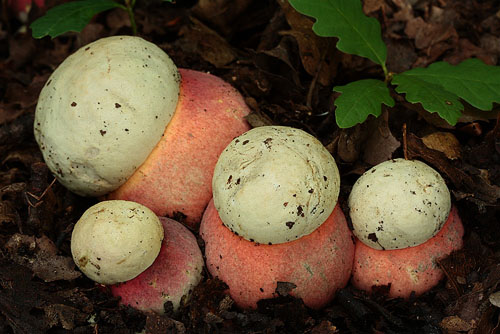
Young fruitbodies of Boletus satanas. (photo M. Mikšík)
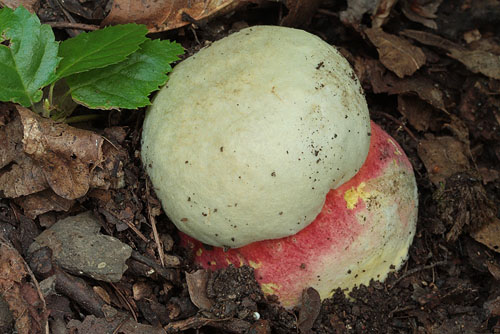
Young fruitbody of Boletus satanas. (photo M. Mikšík)
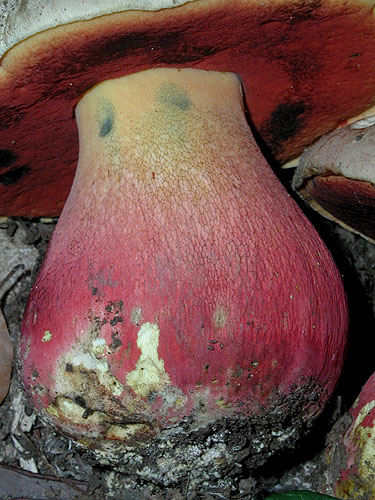
Detail of the stipe of Boletus satanas. Note the fine network. (photo B. Assyov)
Important literature
Alessio, C.L. 1985. Boletus Dill. ex L. (sensu lato). – In: Fungi Europaei. Vol. 2. Pp. 1–705. Libreria editrice Biella Giovanna, Saronno.
Breitenbach J. & Kränzlin F. 1991. Pilze der Schweiz. Bd. 3(1). Röhrlinge und Blätterpilze. Verlag Mykologia, Luzern.
Engel, H., Krieglsteiner, G., Dermek, A. & Watling, R. 1983. Dickröhrlinge. Die Gattung Boletus in Europa. Verlag Heinz Engel, Weidhausen b. Coburg.
Estadès, A. & Lannoy, G. 2004. Les bolets européens. – Bulletin Mycologique et Botanique Dauphiné-Savoie 44(3): 3–79.
Galli, R. 1998. I Boleti. Atlante pratico-monographico per la determinazione dei boleti. Edinatura, Milano.
Hansen, L. & Knudsen, H. 1992. Nordic Macromycetes. Vol. 2. Polyporales, Boletales, Agaricales, Russulales. Nordsvamp, Copenhagen.
Knudsen, H. & Vesterholt, J. [eds.]. 2008. Funga Nordica. Nordsvamp, Kopenhagen.
Lannoy, G. & Estadès, A. 2001. Les Bolets. Flore mycologique d’Europe. Documents Mycologiques Mémoire Hors série no. 6. Pp. 1–163. Association d’Écologie et de Mycologie, Lille.
Muñoz, J.A. 2005. Boletus s. l. – In: Fungi Europaei. Vol. 1. Pp. 1–951. Edizioni Candusso, Alassio.
Pilát, A. & Dermek, A. 1974. Hríbovité huby. Československé hríbovité a sliziakovité huby (Boletaceae – Gomphidiaceae). Veda, Bratislava.
Singer, R. 1967. Die Röhrlinge. II. Die Boletoideae und Strobilomycetaceae. – In: Die Pilze Mitteleuropas. Vol. 6. Pp. 1–151. Julius Klinkhardt Verlag, Bad Heilbrunn.
Šutara, J., Mikšík, M. & Janda, V. 2009. Hřibovité houby. Čeled’ Boletaceae a rody Gyrodon, Gyroporus, Boletinus a Suillus. Academia, Praha.
Watling, R. 1970. Boletaceae, Gomphidiaceae, Paxillaceae. – In: Henderson, D.M., Orton, P.D. & Watling, R. [eds]. British fungus flora. Agarics and Boleti. Vol. 1. Royal Botanic Garden, Edinburgh.
Watling, R. & Hills, A.E. 2005. Boletes and their allies (revised and enlarged edition). – In: Henderson, D.M., Orton, P.D. & Watling, R. [eds]. British Fungus Flora. Agarics and boleti. Vol. 1. Royal Botanic Garden, Edinburgh.